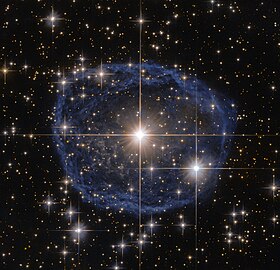This is an old revision of this page, as edited by Lithopsian (talk | contribs) at 22:37, 10 March 2016 (Tags and fixes). The present address (URL) is a permanent link to this revision, which may differ significantly from the current revision.
Revision as of 22:37, 10 March 2016 by Lithopsian (talk | contribs) (Tags and fixes)(diff) ← Previous revision | Latest revision (diff) | Newer revision → (diff) WR 31a Credit: ESA/Hubble & NASA Acknowledgement: Judy Schmidt | |
| Observation data Epoch J2000.0 Equinox J2000.0 | |
|---|---|
| Constellation | Carina |
| Right ascension | 10 53 59.586 |
| Declination | −60° 26′ 44.31″ |
| Apparent magnitude (V) | 10.85 |
| Characteristics | |
| Spectral type | WN11h |
| Variable type | cLBV |
| Astrometry | |
| Proper motion (μ) | RA: −3.6 mas/yr Dec.: 4.0 mas/yr |
| Distance | 8,000 pc |
| Absolute magnitude (MV) | −6.71 |
| Details | |
| Mass | 45 M☉ |
| Luminosity | 1,820,000 L☉ |
| Temperature | 30,200 K |
| Other designations | |
| WR 31a, Hen 3-519, IRAS 10520-6010, GSC2 S1113013697, 2MASS J10535958-6026444, AAVSO 1050-59 | |
| Database references | |
| SIMBAD | data |
WR 31a is a Wolf-Rayet star in the southern constellation of Carina that is surrounded by an expanding bubble nebula. It is more commonly referred to as Hen 3-519, as it was known before being listed in the Catalogue of Wolf Rayet stars. It is a suspected, dormant, or post-Luminous Blue Variable (LBV).
Properties
The spectrum of Hen 3-519 contains both absorption and emission lines, intermediate between a hot supergiant and a Wolf-Rayet. On this basis it has been classified as Ofpe/WN9, a slash star. The same type of spectrum is also known as WN11, an extension of the traditional nitrogen sequence to cooler temperatures. It is a hydrogen-rich star, a young object rather than a highly evolved dying star.
The almost unique nature of WR 31a and its unusual spectrum make determination of its distance and physical properties very uncertain. It lies in a direction near the Carina Nebula and Carina OB2 but is thought to be more distant than either. It is close to AG Carinae, another highly luminous WNL star and is calculated to be at a similar distance.
Luminous Blue Variable
Hen 3-519 has been considered as a possible LBV almost since the term was first coined, although it has never shown the characteristic LBV variability. Its properties place it at the limit of temperature and luminosity for such stars, although comparable to the confirmed LBV AG Carinae.
Bubble Nebula
The nebula around WR 31a was first catalogued by Ellen Dorrit Hoffleit in 1953 as the planetary nebula Hf 39. Since 2013, the object has been considered not a planetary nebula but rather, an expanding shocked gas shell, formally classified as a Wolf–Rayet nebula or WR nebula. Its observed expansion velocity is 365 km.s, estimated to be some 2.4 parsecs across.
References
- ^ Høg, E.; Fabricius, C.; Makarov, V. V.; Urban, S.; Corbin, T.; Wycoff, G.; Bastian, U.; Schwekendiek, P.; Wicenec, A. (2000). "The Tycho-2 catalogue of the 2.5 million brightest stars". Astronomy and Astrophysics. 355: L27. Bibcode:2000A&A...355L..27H.
- ^ Toalá, J. A.; Guerrero, M. A.; Ramos-Larios, G.; Guzmán, V. (2015). "WISE morphological study of Wolf-Rayet nebulae". Astronomy & Astrophysics. 578: A66. arXiv:1503.06878. Bibcode:2015A&A...578A..66T. doi:10.1051/0004-6361/201525706.
- ^ Nazé, Y.; Rauw, G.; Hutsemékers, D. (2012). "The first X-ray survey of Galactic luminous blue variables". Astronomy & Astrophysics. 538: A47. arXiv:1111.6375. Bibcode:2012A&A...538A..47N. doi:10.1051/0004-6361/201118040.
- Van Der Hucht, Karel A. (2001). "The VIIth catalogue of galactic Wolf-Rayet stars". New Astronomy Reviews. 45 (3): 135. Bibcode:2001NewAR..45..135V. doi:10.1016/S1387-6473(00)00112-3.
- Smith, Nathan; Tombleson, Ryan (2015). "Luminous blue variables are antisocial: Their isolation implies that they are kicked mass gainers in binary evolution". Monthly Notices of the Royal Astronomical Society. 447: 598. arXiv:1406.7431. Bibcode:2015MNRAS.447..598S. doi:10.1093/mnras/stu2430.
{{cite journal}}: CS1 maint: unflagged free DOI (link) - Crowther, Paul A. (2007). "Physical Properties of Wolf-Rayet Stars". Annual Review of Astronomy & Astrophysics. 45: 177. arXiv:astro-ph/0610356. Bibcode:2007ARA&A..45..177C. doi:10.1146/annurev.astro.45.051806.110615.
- Davidson, Kris; Humphreys, Roberta M.; Hajian, Arsen; Terzian, Yervant (1993). "He 3-519 - A peculiar post-LBV, pre-WN star?". Astrophysical Journal. 411: 336. Bibcode:1993ApJ...411..336D. doi:10.1086/172833.
- Frew, D. J.; Bojicic, I. S.; Parker, Q. A. (2013). "A catalogue of integrated Hα fluxes for 1258 Galactic planetary nebulae". Monthly Notices of the Royal Astronomical Society. 431: 2. Bibcode:2013MNRAS.431....2F. doi:10.1093/mnras/sts393.
{{cite journal}}: CS1 maint: unflagged free DOI (link)
| Constellation of Carina | |||||||||||
|---|---|---|---|---|---|---|---|---|---|---|---|
| Stars |
| ||||||||||
| |||||||||||
| Star clusters |
| ||||||||||
| Nebulae |
| ||||||||||
| Galaxies |
| ||||||||||
| |||||||||||
| |||||||||||